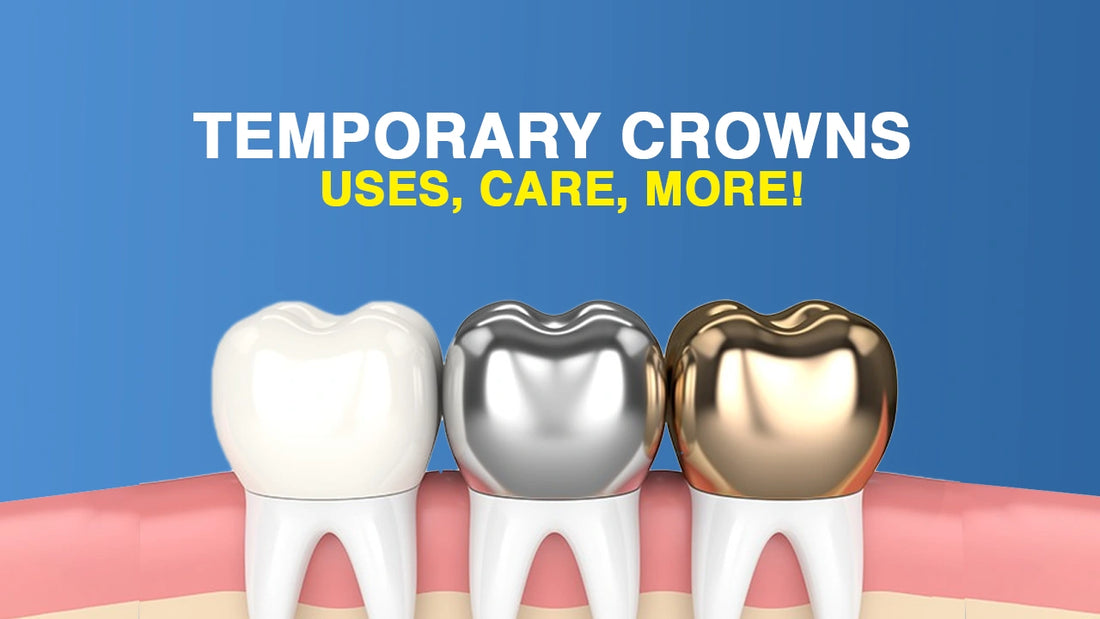A temporary crown helps to protect your teeth or new implants when your permanent crown is under production. Dentists usually recommend temporary crowns if your teeth have a large cavity and need a filling. In that case, the cavity is too large, leaving a little part of the tooth to keep the filling. However, some people may need temporary crowns to prevent further decay of their teeth. Moreover, some people use them for cosmetic use. With the revolution of technology, dentists can manufacture a permanent crown in hours.
However, not all dentists have the expensive technology to make crowns in a short time. Let’s explore some major uses of temporary crowns, why you need them, where to buy them, and many more!
A Little Overview of a Temporary Crown
Usually, it takes some days to manufacture a permanent crown. Therefore, your dentists make a temporary crown for you to protect your tooth. It has the shape of a tooth, which easily fixes damaged areas of the tooth. A dexiter temporary crown from franklin dental supply offers ease of eating and speaking comfortably. Moreover, it's best to keep your tooth in its original place so that the permanent crown may fit properly. It is like a natural tooth in size and shape. That’s why they can cover a full tooth, including its affected parts, and save it from bacteria and decay.

What are temporary crowns made of?
As we need a temporary crown for a short time, that’s why their manufacturing is not up to the mark. Dentists choose these crowns by considering that they will be in place for a limited duration. Most commonly, temporary crowns feature the materials like acrylic, composite resin, or stainless steel. These materials are durable enough to withstand daily activities such as chewing and speaking but are for long-term use.
What Does a Temporary Crown Look Like?
A temporary crown closely resembles a natural tooth in both size and shape. Dentists take impressions of the prepared tooth or implant site to create a temporary tooth cover that fits precisely. The colour of the crown may not perfectly match the surrounding teeth, but its design is similar. Dentists temporarily secure crowns in place with temporary crown cement. They allow for easy removal when the permanent crown is ready.
This cement provides a strong bond while still allowing the dentist to remove the temporary crown. Doing this won’t cause damage to the underlying tooth structure. Here are some types of temporary crowns:

1. Acrylic Crowns
Acrylic crowns are often the go-to choice for many dentists. Due to their exceptional customizability, ensuring a precise fit for the patient's unique dental structure. These crowns allow for a swift creation of a temporary solution, meeting immediate needs. Known for their remarkable versatility, acrylic temporary crowns prove suitable for a diverse range of teeth. They contribute to their widespread adoption in dental practices.
2. Composite ResinTemporary Crowns
Composite temporary crown stands out as a popular choice. They are useful because of their tooth-colored appearance, they offer a more aesthetically pleasing solution. They are soft and easily mould to the shape of teeth. Durable and resilient, they effectively withstand the daily forces. Dentists often opt for composite resin for anterior teeth. They intend to prioritize a natural appearance to enhance the overall cosmetic outcome.
3. Stainless Steel Temporary Crowns
Stainless steel temporary crowns find common usage for posterior teeth. They are known for their ability to endure the substantial pressures associated with chewing on back teeth. They are not as visually appealing as their acrylic or composite resin counterparts. Stainless steel crowns excel in fulfilling their intended purpose with efficiency. They ensure effective functionality in the posterior regions of the mouth.
How Long Does a Temporary Crown Last?
The lifespan of a temporary crown varies from patient to patient and depends on various factors. On average, a crown can last anywhere from a few days to a few weeks. It's important to note that temporary crowns design is not for long-term use. They serve as a placeholder until the permanent crown is ready for placement. Several factors can influence the durability of a temporary crown. Including the material and the location of the tooth in the mouth. Also, the patient's oral habits are crucial. Patients are advised to follow their dentist's recommendations for care and maintenance. It will ensure the crown remains intact until the permanent crown is ready.

Temporary Crown Cement – Securing the Temporary Solution
Temporary crown cement plays a crucial role in ensuring the temporary crown stays in place. Until the permanent crown is ready for placement. This dental cement provides a secure bond while allowing for easy removal when necessary. The application of crown cement is a standard part of the process when fitting a temporary crown. Dentists carefully apply the cement to the inner surface of the crown. They do this before gently placing it over the prepared tooth or implant. The cement sets within a specific timeframe, creating a stable bond.
Patients with temporary crowns need to follow their dentist's instructions regarding oral care. While crown cement provides a strong bond, certain actions, such as biting on hard objects or sticky foods. However, you should avoid dislodging the crown prematurely.
Learn More About Us:
Dental Cement to Secure Restoration - Types and OverviewFinal Verdict
Temporary crowns serve a crucial role in maintaining oral health while waiting for the fabrication of permanent crowns. You can use them to protect a tooth with a large cavity, during cosmetic procedures. While waiting for an implant to heal, these temporary solutions offer practical benefits. Understanding the materials used in temporary crowns, dental crown cement provides insight into their importance in dental care. If you find yourself in need of a temporary crown, it's essential to follow your dentist's recommendations. They will be a handful for care and maintenance to ensure a smooth transition to permanent restoration.

